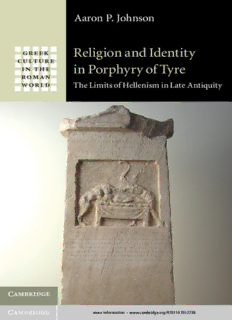Table Of Contentmore information - www.cambridge.org/9781107012738
RELIGION AND IDENTITY IN
PORPHYRY OF TYRE
Porphyry,anativeofPhoeniciaeducatedinAthensandRomeduring
thethirdcenturyad,wasoneofthemostimportantPlatonicphiloso-
phersofhisage.Inthisbook,ProfessorJohnsonrejectstheprevailing
modern approach to his thought, which has posited an early stage
dominatedby“Oriental”superstitionandirrationalityfollowedbya
secondrationalizingorHellenizingphaseconsequentuponhismove
WestandexposuretoNeoplatonism.Basedonacarefultreatmentof
alltherelevantremainsofPorphyry’soriginallyvastcorpus(muchof
whichnowsurvivesonlyinfragments),hearguesforacomplexunity
ofthoughtintermsofphilosophicaltranslation.Thebookexplores
thisphilosopher’scriticalengagementwiththeprocessesofHellenism
in late antiquity. It provides the first comprehensive examination of
all the strands of Porphyry’s thought that lie at the intersection of
religion,theology,ethnicity,andculture.
aaron p. johnsonisAssistantProfessorofHumanitiesandClas-
sicsatLeeUniversity,workingontheintellectualandculturalhistory
oflateantiquity.HeisalsotheauthorofEthnicityandArgumentin
Eusebius’PraeparatioEvangelica(2006).
greek culture in the roman world
Editors
susan e. alcock, BrownUniversity
jas´ elsner, CorpusChristiCollege,Oxford
simon goldhill, UniversityofCambridge
TheGreekcultureoftheRomanEmpireoffersarichfieldofstudy.Extraordinaryinsights
canbegainedintoprocessesofmulticulturalcontactandexchange,politicalandideological
conflict,andthecreativityofachanging,polyglotempire.Duringthisperiod,manyfun-
damentalelementsofWesternsocietywerebeingsetinplace:fromtheriseofChristianity,
toaninfluentialsystemofeducation,tolong-livedartisticcanons.Thisseriesisthefirst
to focus on the response of Greek culture to its Roman imperial setting as a significant
phenomenoninitsownright.Tothisend,itwillpublishoriginalandinnovativeresearch
intheart,archaeology,epigraphy,history,philosophy,religion,andliteratureoftheempire,
withanemphasisonGreekmaterial.
Recenttitlesintheseries:
GalenandtheWorldofKnowledge
EditedbyChristopherGill,TimWhitmarsh,andJohnWilkins
LocalKnowledgeandMicroidentitiesintheImperialGreekWorld
EditedbyTimWhitmarsh
HomerBetweenHistoryandFictioninImperialGreekLiterature
LaurenceKim
FacingtheGods:EpiphanyandRepresentationinGraeco-RomanArt,
LiteratureandReligion
VerityPlatt
Narrative,IdentityandtheAncientGreekNovel
TimWhitmarsh
WomenandVisualReplicationinRomanImperialArtandCulture
JenniferTrimble
TheMaeanderValley:AHistoricalGeographyfromAntiquitytoByzantium
PeterThonemann
GreeceandtheAugustanCulturalRevolution
J.S.Spawforth
RethinkingtheGods:PhilosophicalReadingsofReligioninthePost-HellenisticPeriod
PeterVanNuffelen
SaintsandSymposiasts:TheLiteratureofFoodandtheSymposiumin
Greco-RomanandEarlyChristianCulture
JasonKo¨nig
TheSocialWorldofIntellectualsintheRomanEmpire:Sophists,Philosophers,andChristians
KendraEshleman
RELIGION AND IDENTITY
IN PORPHYRY OF TYRE
The Limits of Hellenism in Late Antiquity
AARON P. JOHNSON
cambridge university press
Cambridge,NewYork,Melbourne,Madrid,CapeTown,
Singapore,Sa˜oPaulo,Delhi,MexicoCity
CambridgeUniversityPress
TheEdinburghBuilding,Cambridgecb28ru,UK
PublishedintheUnitedStatesofAmericabyCambridgeUniversityPress,NewYork
www.cambridge.org
Informationonthistitle:www.cambridge.org/9781107012738
(cid:2)c AaronP.Johnson2013
Thispublicationisincopyright.Subjecttostatutoryexception
andtotheprovisionsofrelevantcollectivelicensingagreements,
noreproductionofanypartmaytakeplacewithoutthewritten
permissionofCambridgeUniversityPress.
Firstpublished2013
PrintedandboundintheUnitedKingdombytheMPGBooksGroup
AcatalogrecordforthispublicationisavailablefromtheBritishLibrary
LibraryofCongressCataloginginPublicationdata
Johnson,AaronP.
ReligionandidentityinPorphyryofTyre:thelimitsofHellenisminlateantiquity/
AaronP.Johnson.
pagescm.–(GreekcultureintheRomanworld)
Includesbibliographicalreferencesandindex.
isbn978-1-107-01273-8
1.Porphyry,ca.234-ca.305. I.Title.
b697.z7j64 2013
186(cid:3).4–dc23 2012035050
isbn978-1-107-01273-8Hardback
CambridgeUniversityPresshasnoresponsibilityforthepersistenceor
accuracyofURLsforexternalorthird-partyinternetwebsitesreferredto
inthispublication,anddoesnotguaranteethatanycontentonsuch
websitesis,orwillremain,accurateorappropriate.
ForHeidi,AlbianandAsher
(cid:2)(cid:3)(cid:4)(cid:5)(cid:6)(cid:7)(cid:8)(cid:9)(cid:2)(cid:9)(cid:10)(cid:11)(cid:12)(cid:11)(cid:13)(cid:14)(cid:8)(cid:15)(cid:9)(cid:4) 949
(HomerIliad . )
Contents
Acknowledgments pageviii
Noteonabbreviations ix
1 AtthelimitsofHellenism:anintroduction 1
part i a world full of gods: porphyry
the theologian
2 Porphyry’staxonomyofthedivine 53
3 Salvation,translation,andthelimitsofcult 102
4 Themasterreader:contextsoftranslation 146
part ii a world full of nations: porphyry the
ethnographer
5 Knowledgeandnations:Porphyry’sethnicargumentation 189
6 EthnicparticularismandthelimitsofHellenism 222
7 Thewayhome:transcendingparticularism 258
Epilogue:translationafterPorphyry 300
Appendix1:Annotatedtableofselectfragments 307
Appendix2:Translationofselectfragments 331
Workscited 347
Index 372
vii
Acknowledgments
Porphyrymademanyenemiesinantiquity;Ihavebeenfortunatetohave
metmanyfriendswhileworkingonPorphyry.Thisbookandtheresearch
onwhichitrestshavebeensustainedbythekindnessandencouragement
of colleagues, students, and friends. For a myriad of stimulating conver-
sations, criticisms, and advice I am grateful to Chris Faraone, Sebastien
Morlet, Margaret Mitchell, Noel Lenski, Scott Johnson, Jack Tannous,
JosephMiller,JanghoJo,JohnGrangerCook,ArianeMagny,KateCooper,
JaredWielfaert,andGillianClark.HeidiMarx-Wolf,ToddKrulak,Aude
Busine, Ilinca Tanaseanu-Do¨bler, and Isha Gamlath kindly provided me
with prepublication versions of their own research. Heidi Johnson, Guy
Stroumsa,HeidiMarx-Wolf,ToddKrulak,andJohnDillonreadportions
of this book and gave much useful insight on improving its shortcom-
ings. Of the series editors, Ja´s Elsner gave particularly pointed advice on
improvingseverallinesofargument.Myassistant,MelissaPhillips,greatly
helpedintheformattingofthemanuscript.Overthepastsixyearsvarious
aspectsofmyworkonPorphyrywerepushedandredirectedbyaudiences
at: Duke’s Center for Late Antique Studies; two separate meetings of the
Shifting Frontiers in Late Antiquity conferences at Boulder and Bloom-
ington; the Late Antiquity in Illinois conference at Urbana-Champaign;
multiple workshops at the University of Chicago; the Models of Piety in
LateAntiquitygroupatthe2008SBL;WashingtonUniversity;University
ofParis–Sorbonne;St.DeiniolsLibrary,Hawarden(undertheauspicesof
ManchesterCentrefortheStudyofLateAntiquity).Ihavebeenfortunate
toreceivethefinancialsupportoftheSocietyofFellowsattheUniversity
of Chicago (which provided an excellent context to write the bulk of the
presentbook);theNationalEndowmentfortheHumanities;andLeeUni-
versityFacultyResearchGrant.Thepositionstakenandanyshortcomings
inthefollowingpagesremainmyown.Finally,Imustthankmyfamilyfor
goodhumor,persistentlypretendingtobeinterested,andforcingnecessary
diversions.Iscarcelydeservetheloveandcommitmenttheyhaveshown.
viii
Description:Porphyry, a native of Phoenicia educated in Athens and Rome during the third century AD, was one of the most important Platonic philosophers of his age. In this book, Professor Johnson rejects the prevailing modern approach to his thought, which has posited an early stage dominated by 'Oriental' sup

